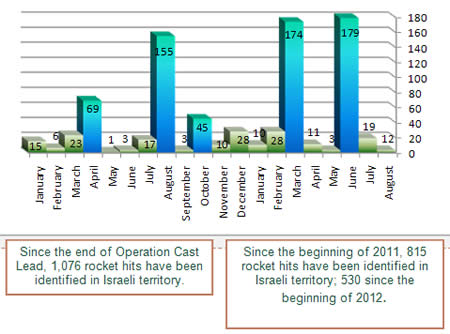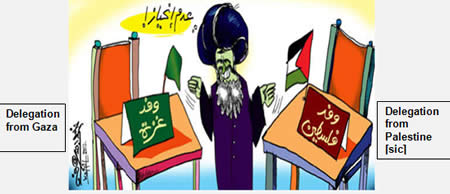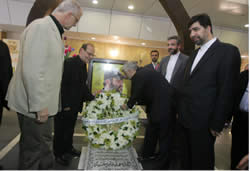- This past week terrorist events focused on rocket fire (six identified hits) targeting the western Negev shortly before the opening of the new school year. An umbrella network in the Gaza Strip affiliated with the global jihad claimed responsibility for the attacks. Israeli Air Force aircraft struck two terrorist sites for the manufacture of weapons in the northern Gaza Strip.
- On August 28 the Haifa District Court dismissed a civil claim lodged by the family of Rachel Corrie, an activist belonging to the anti-Israeli organization International Solidarity Movement (ISM), who was run over by an IDF bulldozer near the Philadelphi route in the southern Gaza Strip in 2003. According to the judgment handed down, the bulldozer and its driver were carrying out military actions under fire in a war zone and the death of Rachel Corrie was the result of "an accident [that] was self-inflicted" (Ynet, August 23, 2012).
Rocket Fire Targeting Sderot
- This past week six rocket hits were identified in Israeli territory, fired close to the opening of the new school year:
- On August 26, at around 9:00 in the morning three rockets fell in Sderot. One hit a factory. Another fell near a factory in a nearby industrial zone; there were no casualties but factories were damaged. The third fell in an open area near a residential home. There were no casualties and no damage was done.
- On August 27, the first day of the new school year, three rockets fell in Israel's south at around 8:00 in the morning, as elementary school children and kindergarteners were on their way to school. One of the rockets fell in Sderot in an open area. There were no casualties and no damage was done.
- Responsibility for the rocket fire was claimed by a network in the Gaza Strip calling itself the Holy Fighters of Greater Jerusalem. The network said in an announcement that the rockets had deliberately been fired on the first day of school (Global jihad forum, August 27, 2012). The Holy Fighters of Greater Jerusalem is an umbrella network in the Gaza Strip which includes Tawhid wal-Jihad and Ansar al-Sunna, both affiliated with the global jihad.[1]
IDF Response to the Rocket Fire
- In response to the rocket fire from the Gaza Strip, on the night of August 28 Israeli Air Force planes struck two sites for the manufacture and storage of weapons in the northern Gaza Strip.
Rockets Fired into Israeli Territory[2]

The Supporters of Jerusalem Claim Responsibility for Rocket Fire Targeting Eilat
A network in the Sinai Peninsula affiliated with Al Qaeda called the Supporters of Jerusalem (Ansar bayt al-quds) claimed responsibility for rocket fire targeting Israel's southernmost city, Eilat, posting a video on August 25 documenting the attack. The Supporters of Jerusalem first called attention to themselves on July 24, 2012, when they posted a video claiming responsibility for blowing up the Sinai Peninsula pipeline bringing gas from Egypt to Israel. The video was entitled "If you return to your evil ways so will we," and its message was that if Egypt continued supplying its natural resources to the "Zionists" and "betrayed the homeland," then the organization would sabotage the pipeline again with stronger explosives (YouTube, July 24, 2012).

From the video documenting the rocket attack on Eilat (Pictures from YouTube, August 25, 2012)
Demonstrations at the Traditional Friction Points
- This week as well there were riots at the traditional friction points in Judea and Samaria, especially the villages of Bila'in, Nili'in and Nebi Saleh. Rioters threw stones at the IDF forces, who in certain instances used riot control equipment to disperse the demonstrators. In addition, in a number of instances stones and Molotov cocktails were thrown at Israeli civilian and security vehicles.
Continuing Egyptian Security Activities in the Sinai Peninsula
- This past week Egyptian security forces continued their activities in the Sinai Peninsula, with an emphasis on destroying tunnels under the Egyptian-Gaza border in the Rafah region (Safa News Agency, August 20, 2012). According to Egyptian sources, 120 tunnels have already been sealed (Radio Sawt, August 25, 2012).
- Egyptian sources said that the Egyptian army engineering corps had been particularly successful in closing tunnels using a newly developed, more effective method for which focused on destroying the tunnels in a way that would prevent their owners from restoring and reopening them (Ma'an News Agency, August 27, 2012). An Egyptian security source estimated that because of the large number of tunnels that had to be sealed, the operation would take four months (Filastin al-Yawm, August 26, 2012).
The Rafah Crossing
- This past week Egypt announced that the Rafah crossing would be open in both directions all week (Hamas' palestine-info website, August 25, 2012). The decision to leave it open for only three days was changed because it enraged the Gazans (Ma'an News Agency, August 25, 2012).
- Senior Hamas figures expressed satisfaction with the change:
- Sami Abu Zuhri,Hamas spokesman in the Gaza Strip, said that reopening the Rafah crossing was proof of the Egyptian leadership's sincerity toward the Palestinians, especially those in the Gaza Strip, and it showed that the Egyptian president was keeping his promise to make it easier for Gazans to use the crossing (Filastin al-'Aan, August 25, 2012).
- Jamal al-Khudari, head of the Popular Committee against the Siege and a member of the Palestinian Legislative Council, expressed appreciation for the Egyptian decision (Safa News Agency, August 25, 2012).
- In the meantime, Hamas continues pushing for the establishment of a free trade zone on the Egyptian-Gaza border at Rafah in compensation for the closing of the tunnels. Yousuf Rizqa, political advisor to Ismail Haniya, said that Hamas and the Egyptians had been discussing the idea for a long time and that the ministry of the economy of the de-facto Hamas administration had presented Egypt with a detailed plan. He said a free trade zone would make it possible for both sides to oversee merchandise that passed through the crossing (Qudsnet website, August 23, 2012).
The Military Wing of the Popular Resistance Committees Opens a "Military Academy"
- The military-terrorist wing of the Popular Resistance Committees announced the opening of a "military academy" whose goal would be "to improve the fighting capabilities of the wing's operatives." The "academy" is named for Imad Hamad,[3] and studies will focus on two areas: theoretical studies, including Islamic religious law, and practical training on the ground (Qawm website, August 25, 2012).
Hamas Minister of Prisoner Affairs Calls for Suicide Bombing Attacks and Abductions
- At the weekly demonstration of the prisoners' families held in front of Red Cross headquarters in Gaza City, Atallah Abu al-Sabah, minister of prisoner and released prisoner affairs in the de-facto Hamas administration, called for suicide bombing attacks and "resistance" (i.e., terrorism) in Judea, Samaria and the Gaza Strip, as well as the abduction and murder of Israelis to secure the release of Palestinian prisoners (The PIJ's Paltoday website, August 27, 2012).
Strong Anti-Israel Hate Propaganda Marks the Anniversary of the Attempted Arson of Al-Aqsa Mosque
- The 43rd anniversary of the attempted arson of Al-Aqsa mosque[4] was exploited by Mahmoud Abbas' office as an excuse for a propaganda attack on Israel. His office issued a statement claiming the arson attempt was the first in a series of events designed to destroy Al-Aqsa and take control of the Muslim and Christian holy sites. The statement also claimed that Jerusalem and Al-Aqsa mosque were under an unprecedented attack officially waged by the Israeli government and the Jerusalem municipality, which were taking over areas of Jerusalem and making laws to that end. The statement also made it clear that there would be neither peace, security nor stability "until the occupation, the settlements and the settlers are expelled from the eternal capital of our country" (Wafa News Agency, August 21, 2012).
Palestinian Participation in the Conference of Non-Aligned Countries
- On August 30-31 a conference of non-aligned countries will be held in Tehran, attended by presidents and prime ministers. Iran, which is hosting the conference, invited Mahmoud Abbas to attend. Later Ismail Haniya, head of the de-facto Hamas administration in the Gaza Strip, also received an invitation.
- The subject of Palestinian attendance led to a dispute and an exchange of mutual Fatah-Hamas recriminations. Mahmoud Abbas announced that he would not attend the conference if Ismail Haniya were there, because "no one in the world has the right to divide our unity and representation" (Qudsnet website, August 26, 2012). Salam Fayyad, Palestinian prime minister, criticized the Iranian president for having sent Haniya an invitation. He said that it damaged one of the great achievements of the Palestinian people, whose only and exclusive legitimate representative was the PLO. Thus he appealed to Haniya to put his Palestinian identity and national feelings before anything else (Wafa News Agency, August 25, 2012).
- Hamas initially announced that Haniya would in fact attend the conference, and responded positively to Iran's invitation. However, on August 26 Ismail Haniya announced that he would not attend because he had no wish to worsen the internal Palestinian schism (Safa News Agency, August 26, 2012).
- As a result, the Palestinian newspaper Al-Quds published an editorial criticizing the Iranian regime entitled "Unacceptable Iranian Intervention." It accused Iran of trying to undermine Palestinian unity and perpetuate the internal Palestinian schism by sending two invitations to the conference, one to the Hamas administration in the Gaza Strip and the other to Mahmoud Abbas (Al-Quds, August 26, 2012).

A cartoon in Al-Quds for the conference in Tehran, showing the Iranian leader's satisfaction with the internal Palestinian schism (Al-Quds, August 26, 2012).
Media Reports of a Hezbollah Military Exercise Close in Time to Jerusalem Day
- According to Lebanese sources quoting a detailed article in the Lebanese newspaper Al-Joumhouria, Hezbollah held a large military exercise, the first of its kind, lasting three days and engaging more than ten thousand of its operatives. According to the report, the exercise was held mainly in the region of the Beqa'a Valley and simulated a confrontation with Israel. Hezbollah secretary general Hassan Nasrallah personally oversaw the exercise, accompanied by officers of Iran's Islamic Revolutionary Guards Corps.
- In addition, according to the article, Saeed Jalili, secretary of Iran's Supreme National Security Council, was in Lebanon on August 6 and gave Hezbollah a green light to plan a scenario for the outbreak of a war between Israel and Iran in which Lebanon would be one of the main fighting arenas. Nasrallah and Jalili met outside the southern suburb of Beirut and discussed the issue of Hezbollah's military and logistic preparedness (Al-Joumhouria, August 23, 2012).

Saeed Jalili, secretary of Iran's Supreme National Security Council, pays a visit to the grave of terrorist Imad Mughniyeh during his latest visit to Lebanon (Picture from the Alintiqad website, Lebanon, August 6, 2012).
World Jerusalem Day around the Globe
- The annual Iranian-sponsored World Jerusalem Day events were held, as expected, in Iran, the Arab-Muslim world and other countries. As usual, Iran was the focus of the events and they were attended by the leadership of the regime. Notable events were also held in Lebanon under Hezbollah aegis. In the West, there were demonstrations in London, Berlin and several cities in the United States, and in other countries.
- The events can generally be described as follows:
- A relatively small number of participants in Iran – The organizers in Iran invested in a great deal of propaganda and advertising to encourage the general populace to participate in the events, and claimed that "millions" of people were in attendance. However, foreign correspondents reported that there were fewer participants this year than last and far fewer than in the first years after the Islamic Revolution.
- Poor attendance in other countries– Attendance was markedly poor in the Gaza Strip, where Hamas did not lead the events. In Judea and Samaria as well the events did not make an impression, while in the West, including focal points like London and Berlin, few people attended (even though in London large sums of money were invested in hanging banners on buses). There was also little media coverage, and events around the world were mostly reported by the Iranian media.
- The Iranian-Shiite character of the events was marked– The original intention of holding Jerusalem Day was to show Muslim unity, Shi'ite and Sunni, for the Palestinian cause. In reality, most of the participating organizations and activists were either Shi'ite or affiliated with Iran (in Western countries they were joined by anti-Israeli activists participating in the campaign to delegitimize Israel). Some of the themes of the events were Shi'ite in nature and those on Iran's political agenda, such as support for the Alawite regime in Syria, for the Shi'ites in Bahrain and the Shi'ite Houthis in Yemen.
- The Iranian leadership and Hezbollah repeatedly stressed two issues:
- The call to destroy the State of Israel, variously described as "an artificial entity," "a malignant tumor," and "a threat to humanity." The campaign was accompanied by anti-Semitic hate propaganda describing the "Zionists," that is the Jews, as controlling the United States and in fact the entire world (in the spirit of The Protocols of the Elders of Zion mythology).
- Warning Israel not to attack Iran: The Iranian leaders stressed the necessity of continuing the so-called "resistance" (i.e., terrorism) to destroy Israel while warning it not to attack Iran's nuclear installations ("If Israel miscalculates and attacks Iranian nuclear installations Iran's strong response will destroy the Zionist entity."). Hezbollah leader Hassan Nasrallah added that Hezbollah could also attack the Israeli home front with precision missiles which "will turn the lives of hundreds of Zionists into a living hell."
"Welcome to Palestine 3" Activists Denied Entry into Israel
- An estimated hundred activists from the "Welcome to Palestine 3" initiative arrived in Jordan on August 24 and 25, intending to enter Judea and Samaria through the Allenby crossing. Before reaching the crossing they visited the Palestinian refugee camp at Jerash, in Jordan. The objective of the initiative, according to its organizers, was to highlight Israel's control of entrance into Judea and Samaria.
- On August 26 five buses carrying activists arrived at the Allenby crossing. The activists shouted slogans like "Liberate Palestine" and sang Palestinian national songs. They were refused entry into Israel by the Israeli authorities, and turned around and left.
- After they were refused entry they said they would try again. One of them said that during a conference in Brazil at the end of 2012, they would discuss the possibility of taking legal action against the security measures used by Israel to prevent activists from entering its territory (Voice of Palestine Radio, August 27, 2012).
Haifa Court Dismisses the Claim of the Family of Rachel Corrie, International Solidarity Movement Activist Killed near the Philadelphi Route
- On August 28, 2012, the Haifa District Court dismissed a civil claim lodged by the family of Rachel Corrie, an activist in the anti-Israeli International Solidarity Movement, who was run over by an IDF bulldozer in 2003. According to the court's decision, she "consciously put herself in harm's way," and the accident was self-inflicted. "She did not distance herself from the area, as any thinking person would have done," the judge said. He added that the IDF had done its best to keep her and her friends away from the area. The bulldozer and its driver were in a war zone under fire, he said, and ruled the death of Rachel Corrie an accident, adding that he was not awarding the family monetary damages (Ynet, August 28, 2012).
- Regarding the International Solidarity Movement (ISM), the organization to which Rachel Corrie belonged, the judge said that the ISM "abuses the human rights discourse to blur its actions which are de facto violence." He claimed that it specialized in disrupting IDF activity. "This included an army of activists serving as 'human shields' for terrorists wanted by Israeli security forces, financial and logistical aid to Palestinians including terrorists and their families, and disruption of the sealing of suicide bombers' houses" (Ynet, August 23, 2012).[5]
[1]For further information about networks affiliated with Al Qaeda and the global jihad see the August 13. 2012 bulletin "The Gaza-based Salafist jihadi network Tawhid wal-Jihad carried out the terrorist attack on the Israeli-Egyptian border on June 18, 2012, in which an Israeli civilian was killed..."
[2]As of August 28, 2012.
[3]Commander of the organization's military-terrorist wing, killed in an IDF attack in Rafah in August 2011, following the terrorist attack on Eilat (August 18, 2011).
[4]On August 21, 1969, a young Australian Christian entered Al-Aqsa mosque and lit fire to a scarf soaked with an inflammable liquid and fled the building. The fire damaged a considerable portion of the furniture in the mosque and the pulpit was completely destroyed. The perpetrator was caught by the Israeli police the following day and brought to trial. Deported from Israel, he was hospitalized in a facility for the mentally disturbed in Australia. The arson attempt caused a storm of protest in the Arab-Muslim world; several countries blamed Israel.
[5]For further information see the December 7, 2012 bulletin "The International Solidarity Movement (ISM) is a network founded by extreme American leftists and part of the campaign to delegitimize Israel. In the second intifada it specialized in hindering IDF counterterrorism activity, indirectly supporting terrorism. Its senior figures founded FGM, which plays a central role in the Gaza Strip flotillas."


















